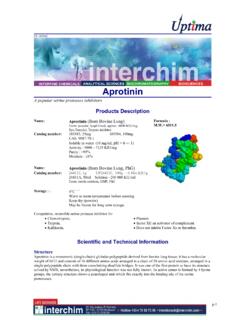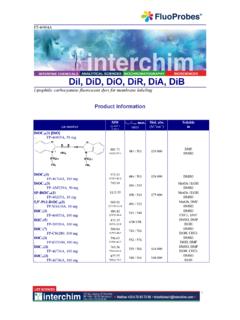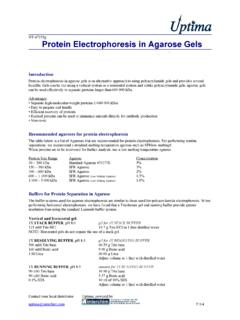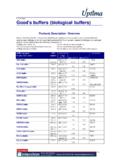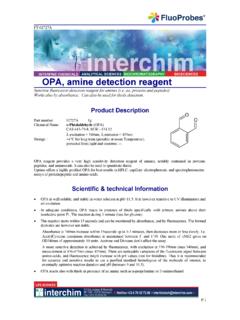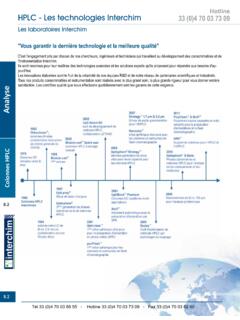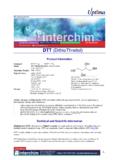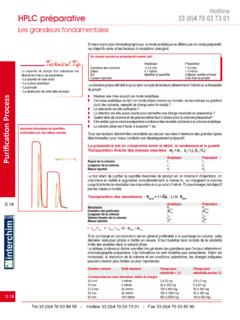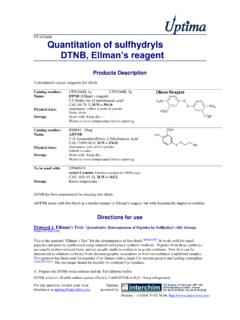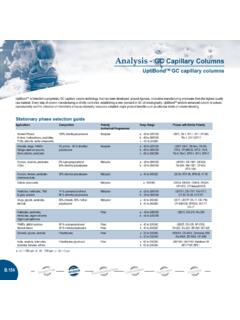Transcription of DTT (DithioThreitol)
1 FT-054721(284251) DTT ( dithiothreitol ) Product Information Catalog #: 054721, 5g 054722, 25g other names: (2S,3S)-1,4-Bis-sulfanylbutane-2,3-diol Threo-1,4-dimercaptobutane-2,3-diol DL-Threo-1,4-dimercapto-2,3-butanediol 1,4-Dithio-DL-threitol, -Threo-1,4-dimercapto-2,3-butanediol Cleland's reagent, Reductacryl Name: DTT ( dithiothreitol ), Biotech grade CAS: 3483-12-3 Molecular Weight : MW: Typical values: Purity: > Abs@283nm ( , water):< Loss on drying: < mp: 39-43 C Oxidized DTT: < Protease: none DNase: none RNase: none Storage: -20 C (or 4 C short term). (M) Protect from moisture.
2 Keep dry Harmful / Irritant; R: 36/37/38; S: 26-36 Cleland s Reagent, or dithiothreitol (DTT), is a water-soluble reducing reagent used for various applications in biotechnology, biology and biochemistry : - reduces quantitatively disulfides, generating sulfhydryls (used typically at 1-10mM for protein SS reduction) - reduction of proteins before SDS-PAGE analysis, studies of protein structure and function (Kaji 1993) - keep sulfhydryl groups of biomolecules in the reduced state - protects biomolecules in various applications (enzymes or receptors, living cells under ionizing radiations) - prevents the fading of fluorescence such as FITC labeled conjugates (Picciolo 1984) Technical and Scientific Information dithiothreitol (DTT)
3 , also known as Cleland's reagent, is a small-molecule redox reagent . Its oxidized form is a disulfide-bonded 6-membered ring. DTT has an epimeric ('sister') compound, dithioerythritol (DTE, #123378). DTT is highly soluble in water (clear solution, OD< at ), but also in ethanol, chloroform, ether and ethyl acetate. DTT participates to disulfide exchange reactions (Zhang 1988) that drives its major applications (see below). In example DTT is used typically at 1-10mM for protein SS reduction. It readily cross biological membranes. FT-054721(284251) Reducing properties DTT is an unusually strong reducing agent, with a redox potential of V at pH 7.
4 The pKa of thiol groups is typically ~ reduction of a typical disulfide bond proceeds by two sequential thiol-disulfide exchange reactions and is illustrated: Reducing ability may be reduced after unproper storage conditions (at room temperature, or in solution). Exposure to air should be minimized, even DTT has a lower tendency to be oxidized directly by air than other reducing agents. DTT useful life can be extended by refrigeration and handling in an inert atmosphere. Since protonated sulfurs have lowered nucleophilicities, DTT becomes less potent as the pH lowers. Applications DTT is widely used in biochemistry works to reduce dissulfide bridges, protect biomolecules, in sample preparation, and to denature proteins before electrophoresis analysis (SDS-PAGE).
5 DTT is frequently used to reduce the disulfide bonds of proteins and peptides. It prevents intramolecular and intermolecular disulfide bonds from forming between cysteine residues of proteins. However, even DTT cannot reduce buried (solvent-inaccessible) disulfide bonds, so reduction of disulfide bonds is sometimes carried out under denaturing conditions ( , at high temperatures, or in the presence of a strong denaturant such as 6 M guanidinium hydrochloride, 8 M urea, or 1% Sodium dodecylsulfate). Conversely, the solvent exposure of different disulfide bonds can be assayed by their rate of reduction in the presence of DTT.
6 DTT is as a reducing or "deprotecting" agent. DTT protects notably enzyme activity loss by the oxidation of sulfhydryl groups (Klonne 1988). The DTT removal is performed by standard (dialysis, gelfiltration). As an antioxidant, it is used as a protective agent against ionizing radiations in living cells (Bick 1968). It has been used to enhance or inhibit enzymes or receptors activity (Bohn 1974/DNA polymerase)(Antil 1967/aldolases)(Reynolds 1990,Aizenman 1989/NMDA receptors) (Sakai T. 1983). The terminal sulfur atoms of thiolated DNA have a tendency to form dimers in solution, especially in the presence of oxygen.
7 Dimerization greatly lowers the efficiency of subsequent coupling reactions such as DNA immobilization on gold in biosensors. Typically DTT is mixed with a DNA solution and allowed to react, and then is removed by filtration (for the solid catalyst) or by chromatography (for the liquid form). DTT can also be used as an oxidizing agent. Its principal advantage is that effectively no mixed-disulfide species are populated, in contrast to other agents such as glutathione. In very rare cases, a DTT adduct may be formed, , the two sulfur atoms of DTT may form disulfide bonds to different sulfur atoms; in such cases, DTT cannot cyclize since it has no remaining free thiols.
8 Hints / reducing proteins and peptides DTT replaces in most applications the very pungent 2-mercaptoethanol. The optimal pH range for DTT is between and , but the reagent can be used effectively at pH DTT is well stable (longer shelf life as a powder than 2-mercaptoethanol), however stock solutions must be used immediately and any remaining solution discarded. Concentrations to use Application ref 1-10 mM to maintain reduced proteins in solution, DTT r 50-100 mM for complete reduction for electrophoresis r After reduction is complete, excess reducing reagents should be removed from the sample to prevent reformation of the disulfide and oxidation.
9 Effectively, soluble reducing agents may interfere with downstream assays (determination of free thiol groups in the sample, coupling of free thiol to a sulfhydryl reactive reagent such as SMCC/MAL-PEO-NHS) or various other applications. Desalting can be performed by desalting columns (UP848742) for direct downstream use of reduced protein/peptides (labeling, conjugation, bioassays). Alternatively this can be done by dialysis (but an long process, and sample is recover more or less diluted). These techniques do not suit well for small molecular weight samples, such as peptides (difficult to separate from the reducing agent), unless using reverse phase chromatography or immobilized reducing agents (#).
10 Source: Methods in Molecular Biology: Protein Stability and Folding, Theory and Practice. Vol. 40, Bret A. Shirley, ed. 1995. FT-054721(284251) reducing proteins for electrophoresis Some proteins get on running SDS PAGE analysis an extra band with twice mol. wt , even when using 2-mercaptoethanol reduction. Switch to DTT reduction, or even better to DTT will achieve more complete reduction r. A standard loading buffer contains 1% SDS, 10% glycerol, 10 mM Tris-Cl, pH , 1 mM EDTA, bromophenol blue tracking dye ~ mg/ml and 10mM dithiothreitol (DTT) as reducing agent. References Aizenman E.
